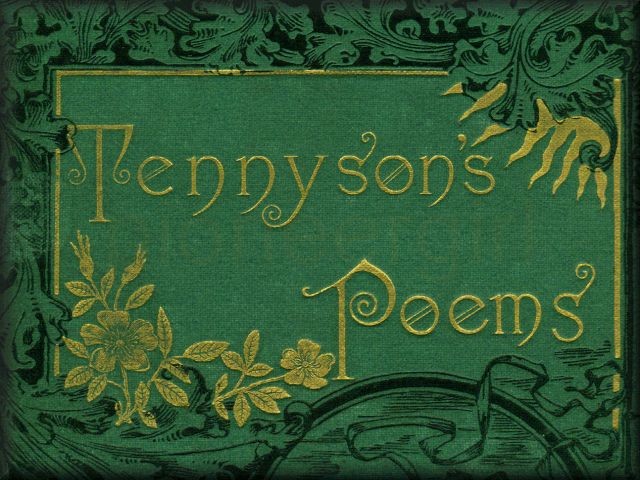Tennyson’s Poems

Collection of works by Written by Alfred, Lord Tennyson, English poet laureate born 1809.
 It was a perfectly new book, beautifully bound in green cloth with a gilded pattern pressed into it… – Little Town on the Prairie, Chapter 12, “Snug for Winter”
It was a perfectly new book, beautifully bound in green cloth with a gilded pattern pressed into it… – Little Town on the Prairie, Chapter 12, “Snug for Winter”
 In Little Town on the Prairie (see Chapter 12, “Snug for Winter”), Laura Ingalls finds a copy of Tennyson’s Poems hidden in Ma’s bureau drawer. Laura reads a portion of the poem “The Lotus Eaters” before realizing the book must have been hidden there as a Christmas present for her. She keeps the secret, and later receives the book as a gift (see Chapter 19, “The Whirl of Gaiety”). “The Lotus Eaters” was by Alfred, Lord Tennyson (1809-1892). It first appeared in his 1842 two-volume work, Poems. In the linked volume, “Maud” is on page 168. “The Lotus Eaters” is on page 29. These two poems are also found in separate entries on pioneergirl.com.
In Little Town on the Prairie (see Chapter 12, “Snug for Winter”), Laura Ingalls finds a copy of Tennyson’s Poems hidden in Ma’s bureau drawer. Laura reads a portion of the poem “The Lotus Eaters” before realizing the book must have been hidden there as a Christmas present for her. She keeps the secret, and later receives the book as a gift (see Chapter 19, “The Whirl of Gaiety”). “The Lotus Eaters” was by Alfred, Lord Tennyson (1809-1892). It first appeared in his 1842 two-volume work, Poems. In the linked volume, “Maud” is on page 168. “The Lotus Eaters” is on page 29. These two poems are also found in separate entries on pioneergirl.com.
While waiting for Mary Power to come by to walk to Ben Woodworth’s birthday party with her, Laura Ingalls tried to overcome her restlessness by reading one of her favorite Tennyson poems. “Maud” is a quite lengthy poem of twenty-two parts; the verses used in Little Town on the Prairie (Chapter 20, “The Birthday Party”) begin Part XXII. It first appeared in Tennyson’s 1855 volume: Maud, and Other Poems; it was also included in The Poetical Works of Alfred Tennyson, published in both one- and two-volume editions by various publishers.
 Scott’s Poems? Notice that Wilder describes her copy of Tennyson’s Poems differently in two chapters of Little Town on the Prairie. In Chapter 12, the book is “green and gilt,” while in Chapter 19, it is “blue and gilt.” It is not known what color Laura’s copy of Tennyson was; in fact, in her handwritten Pioneer Girl manuscript, she receives a copy of Scott’s Poems, not Tennyson’s. This may explain the color confusion. In On the Way Home, Rose Wilder Lane wrote that the Wilders owned copies of both Tennyson’s Poems and Scott’s Poems. Tennyson’s and Scott’s poetry have both been published in editions with covers of various covers, including green and blue.
Scott’s Poems? Notice that Wilder describes her copy of Tennyson’s Poems differently in two chapters of Little Town on the Prairie. In Chapter 12, the book is “green and gilt,” while in Chapter 19, it is “blue and gilt.” It is not known what color Laura’s copy of Tennyson was; in fact, in her handwritten Pioneer Girl manuscript, she receives a copy of Scott’s Poems, not Tennyson’s. This may explain the color confusion. In On the Way Home, Rose Wilder Lane wrote that the Wilders owned copies of both Tennyson’s Poems and Scott’s Poems. Tennyson’s and Scott’s poetry have both been published in editions with covers of various covers, including green and blue.
Sir Walter Scott (1771-1832) was born in Scotland and educated to the bar. He wrote both poems and novels, and is generally hailed as the inventor of the historical novel. His best-known poems include “The Lady of the Lake,” “Marmion,” and “The Lay of the Last Minstrel.” Wilder mentions Sir Walter Scott’s Waverly Novels in The First Four Years.

Tennyson’s Poems (LTP 12, 19-20; THGY 11)
“Come into the Garden, Maud” (LTP 20), see “Come into the Garden, Maud”
“The Lotus Eaters” (LTP 12, 19), see “The Lotus Eaters”

